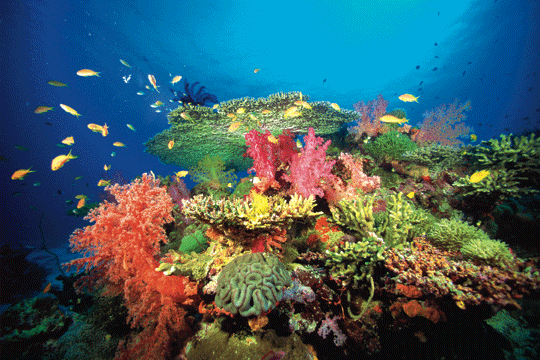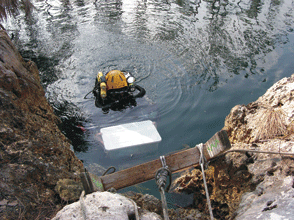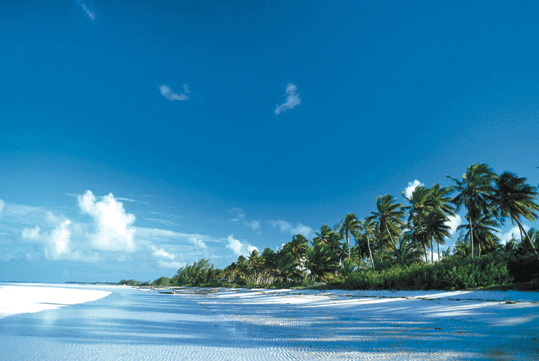
Travel and Adventure
Bahamas
‘Blue Hole’ Lures Divers and Scientists
Sawmill Sink is a unique site. I’ve never seen such an abundance or preservation of fossils anywhere else in the Bahamas or anywhere else in the world, for that matter.
By: Brian Handwerk *
A unique “blue hole” is giving expert divers and scientists a chance to travel back in time for a rare glimpse of life in the pre-human Bahamas.
The deep underwater cave, known as Sawmill Sink, is filled with a treasure trove of well-preserved fossils, including the remains of tortoises and crocodiles previously unknown to exist in the West Indies.
The sinkhole also holds the ancient remains of globally or locally extinct species of lizards, snakes, bats, birds and plants. In addition, the cave has yielded human bones that may be the first-known Bahamian -- a young person who lived some 1,050 years ago.
“On almost every dive we find more fossils,” says Nancy Albury, project coordinator and scientist with the National Museum of the Bahamas, the Antiquities Monuments and Museums Corporation. “Having so many species coming out of one particular site (shows) that there was a lot more going on than we formerly thought in the Bahamas.”
Albury co-authored a paper on the fossils of Sawmill Sink that appeared online in the Proceedings of the National Academy of Sciences.
A blue hole is a sinkhole in which deep saltwater layers are covered by surface fresh water. The underwater caves can be found across the islands of the Bahamas and elsewhere in the Caribbean.
The environment in a blue hole is ideal for preservation, because the salty, oxygen-free waters keep bacteria and fungi from decomposing organic remains. Artifacts are also often covered with layers of protective sediment.
But exploring the sinkholes is risky. Depth, tight spaces, vision-clouding particles and toxic layers of hydrogen sulfide can make blue holes dark and dangerous places to dive.
The Sawmill Sink blue hole lies in a rocky pine forest in the interior of Abaco Island in the northern Bahamas. It was once a dry cave that filled with water as ancient sea levels rose.
Today the sinkhole measures 55 feet (17 meters) across and 110 feet (33.5 meters) deep.
Scuba diver Brian Kakuk, a consultant for the Bahamas museum, discovered the first Sawmill Sink fossil -- a 2,500-year-old giant tortoise shell in excellent condition. Further remains found in the underwater cave range from 1,000 to 4,200 years old.
The most intriguing find to emerge so far has been the remains of an ancient, terrestrial crocodile.
“We believe that this species is almost the same as the Cuban crocodile,” Albury says, of which “there are maybe 3,000 of them left” in the wild and none in the Bahamas.
The rare Cuban crocs live primarily in the water but can also roam on land.
Still, Sawmill Sink would have been a somewhat unlikely location for the croc’s ancient ancestors, at 2 kilometers (1.2 miles) from the nearest body of marine water or mangroves.
Another mystery concerns why the crocodiles and some of their contemporaries, such as two extinct species of tortoise, vanished from the island -- although researchers have their suspicions.
“The climate and environmental conditions back then weren’t much different from those of today,” says David Steadman, a University of Florida ornithologist and study co-author.
“The big difference is (likely) us. When people got to the island, there was probably nothing easier to hunt than tortoises, so they cooked and ate them. And they got rid of the crocodiles because it’s tough to have kids playing at the edge of the village where there are terrestrial crocodiles running around.”
But of everything the sink has yielded so far, plant fossils could turn out to be the most intriguing finds.
By examining leaves, flowers, fruits and seeds alongside the animal remains preserved with them, scientists can form a much more complete picture of the ancient environment. For example, the presence of bracken ferns suggests the island once boasted a regenerative, fire-swept landscape of open grasslands.
Fossils of burrowing owls and meadow larks, which live in such areas, add further convincing evidence.
“There are some really incredible plants coming out,” Albury says. “Some of them still have chlorophyll (pigment). When they are brought to the surface, they are still green.”
Stephanie Schwabe is director of the nonprofit Rob Palmer Blue Holes Foundation based in Charleston, S. C., and was not involved in the Sawmill Sink dives.
While acknowledging the outstanding preservation of the finds at Sawmill Sink, Schwabe suggests that other blue holes could yield more paleontological and archaeological riches.
“We have thousands of different cave systems all over the Bahamas, and the majority of them haven’t even been explored yet,” Schwabe says. “In almost any inland cave (where I’ve dived) I’ve found the remains of some animals. You can’t bury anything. If anything is going to be preserved in the Bahamas, you’re going to find it in the underwater environment.”
For now, though, Sawmill Sink remains one of a kind.
“I’ve been working in the Bahamas for 25 years and (been) diving in many blue holes,” says Thomas Iliffe, an underwater cave expert at Texas A&M University at Galveston. “Sawmill Sink is a unique site. I’ve never seen (such an) abundance or preservation of fossils anywhere else in the Bahamas -- or anywhere else in the world, for that matter.”
* Brian Handwerk is a regular contributor to National Geographic News.